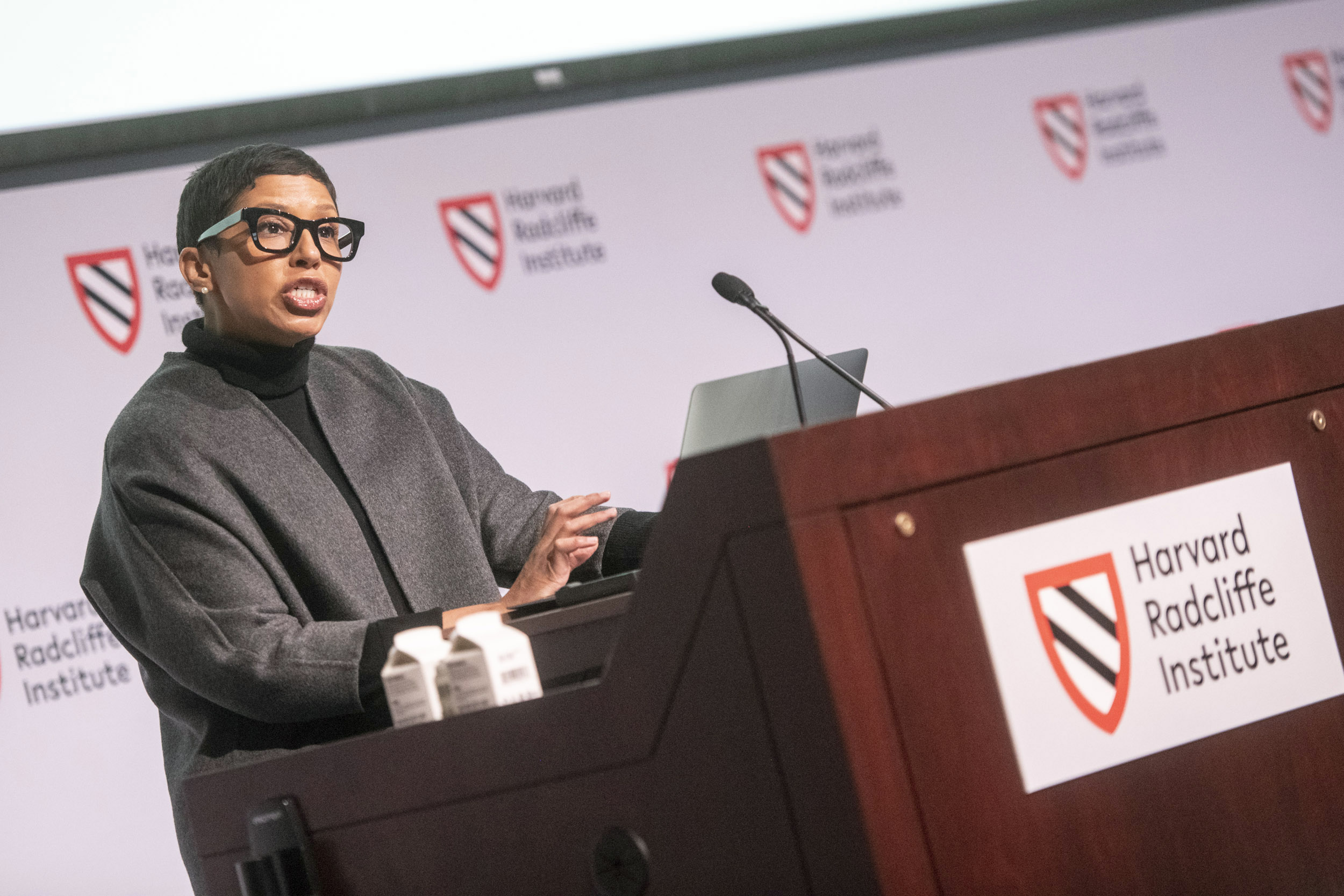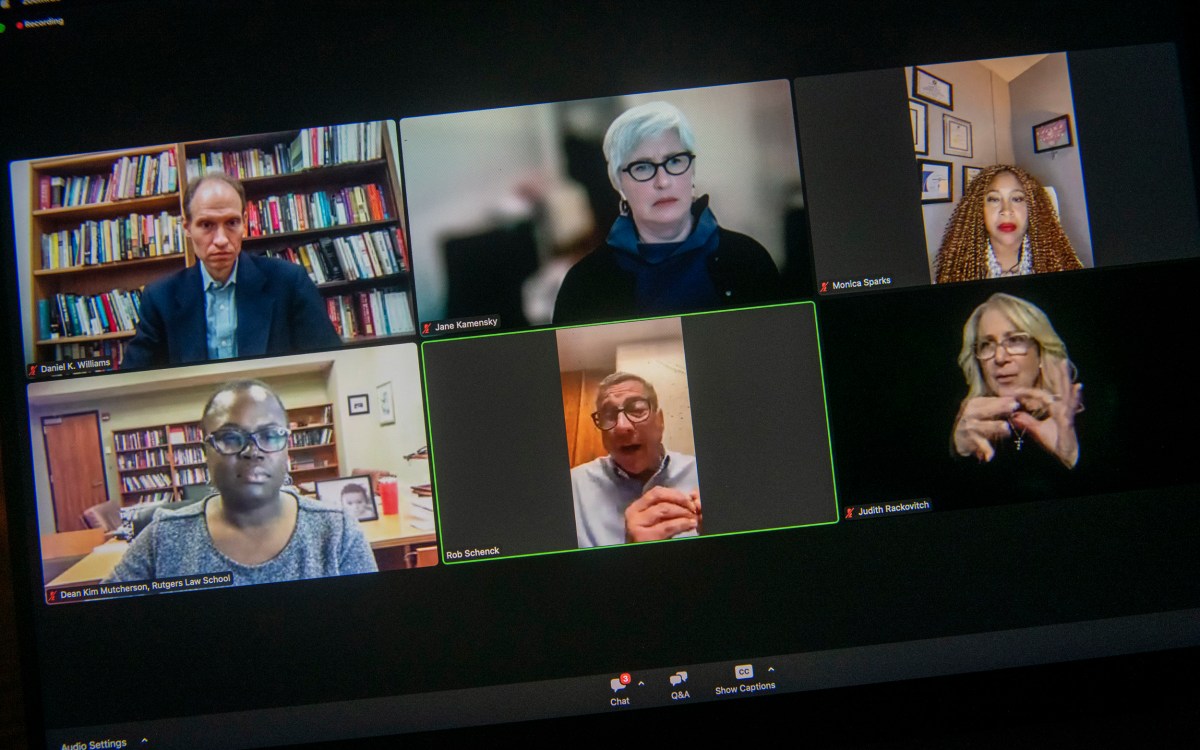
At the “Age of Roe” conference, NYU School of Law Professor Melissa Murray said she anticipates a push by anti-abortion forces for greater restrictions, with the battleground being more localized.
Jon Chase/Harvard Staff Photographer
Lessons of Roe, 50 years later
Speakers at Radcliffe conference look at divisive, fraught history, predict where legal battles go next
Hundreds gathered last week for a two-day conference to commemorate the 50th anniversary of the landmark Roe v. Wade decision, guaranteeing the right to abortion, which was overturned by the Supreme Court last June in Dobbs v. Jackson Women’s Health Organization. The event, hosted by the Harvard Radcliffe Institute, considered the transformational history of Roe and looked at what may lie ahead.
I. Glenn Cohen, James A. Attwood and Leslie Williams Professor of Law and deputy dean at Harvard Law School, said he expects there will likely be geographic, moral, and technological “frontiers” where the anti-abortion movement, which believes a fetus has rights that are not usurped by the mother’s rights, will take its legal battles next.
States that permit abortions or do not prosecute those who come from states where abortion is illegal may be targeted by activists. While some, including Justice Brett Kavanaugh in Dobbs, are skeptical that any ban on interstate travel for abortions will hold up to scrutiny, it’s “far from a clear constitutional matter” and is likely to become an issue in the next 10-15 years, said Cohen, who is also faculty director of the Petrie-Flom Center for Health Law Policy, Biotechnology and Bioethics.
Discarding embryos during in vitro fertilization also will raise debate over when precisely “personhood” begins, and scientific advances that allow gestation outside the womb after fertilization via non-human means could potentially make prohibiting abortion easier to justify, Cohen said.
NYU School of Law Professor Melissa Murray anticipates a push by anti-abortion forces for greater restrictions, with the battleground being more localized.
Murray noted that Justice Samuel Alito’s majority opinion in Dobbs purports to follow the Constitution and merely returns the abortion question to the states, where voters can have their say in a process led by state legislatures. That claim, she argued, is disingenuous and “myopic.”
State legislatures typically tend to be the least representative bodies in state government. Making them the primary arbiters on abortion overlooks the essential roles played by state court judges, attorneys general, governors, and other officials (elected to office by substantially larger numbers of voters than legislators) in interpreting and enforcing reproductive rights law, she said.
Further, the majority’s reference to history and tradition as justification for the Dobbs decision “consists primarily” of examining mid-19th-century statutes enacted during a wave of media furor “aimed at increasing the birth rate among native-born white women,” Murray said. The laws cited “were enacted in an era in which women could not vote, could not hold political office, and were not understood as fully equal members of the polity.”
“The invocation of democratic deliberation is merely a strategic step that deploys the vernacular and values of democracy as cover while it seeks to shift political dynamics to desensitize the populace to a more lasting deprivation of access to … abortion,” she said.
Evelynn Hammonds, Barbara Gutmann Rosenkrantz Professor of the History of Science and of African and African American Studies at Harvard, noted that to understand the imposition of governmental control on women’s bodily autonomy, it’s important to first review “the long and persistent efforts to control the fertility and reproduction of Black women by white men” throughout American history.
“Unlike white Christian men, the historical record shows that migrants’ procreation has been forced, monetized, and monitored since they arrived on U.S. shores. This did not unfold organically or naturally; it was done for specific reasons, to support specific goals, that should be named. Naming the acts that led to and sustained the denial of bodily autonomy to certain women is key to understanding where we are today,” said Hammonds, who is also professor of social and behavioral sciences at Harvard T.H. Chan School of Public Health.
Though many were critical of the Dobbs decision and worried about the effects it could have on women’s physical and mental health and socioeconomic agency, others felt Roe supporters have given too little consideration to what is owed to the developing fetus.
Erika Bachiochi, a fellow at the Ethics and Public Policy Center, a conservative Washington, D.C., think tank, said 19th-century feminists’ views of the interconnectedness that a pregnant woman has with the developing child inside her have much to teach us today, where society and the law under Roe often treats pregnancy “as a woman’s inconvenient and burdensome choice.”
“In my view, a half-century of privileging abortion rights as a means to women’s equality, liberty, and well-being has obviated the need for a total cultural, familial, and economic transformation on behalf of mothers, especially poor mothers and their children,” she said.
Because it raises so many fraught questions about government, religion, health, and the judiciary, abortion has morphed into a kind of “shorthand for our deepest divides,” far removed from how most Americans actually view abortion, said legal historian Mary Ziegler, a UC Davis law professor who co-organized the conference with Jane Kamensky, Carl and Lily Pforzheimer Foundation Director of the Arthur and Elizabeth Schlesinger Library on the History of Women in America and the Jonathan Trumbull Professor of American History at Harvard.
“When you look at the age of Roe, I think you will see something … that is much bigger than abortion. You will see a broad cross-section of Americans who are passionately engaged, and indeed consumed, by an issue that many outside of our borders — and within — believe defines us as a people politically, constitutionally, and culturally,” said Ziegler, author of several books on the legal history of abortion.
“You would see what Harry Blackmun, the author of Roe, learned the hard way and indeed, much too late, and what Samuel Alito will learn soon enough, which is that this is much bigger than the Supreme Court. That the Supreme Court can never settle this once and for all, that this … is bigger than due process, bigger than the judiciary, and well beyond anything the justices can control.”







